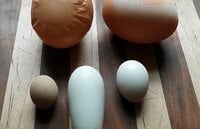Approximately 2% of all chicken eggs have some defect, ranging from minor, barely noticeable faults to downright alarming deformities. So the chances are pretty good that most, if not all flock owners will at some stage find an irregular egg. This article is about the most common egg irregularities and problems and their causes. A few members have asked me if these odd eggs are safe to eat. That depends on the cause of the deformity/irregularity. Most of these eggs, though some may look rather unappetizing, are perfectly safe for human consumption. If the cause of the deformity/irregularity is disease or treatment for disease/pest I would play it safe and discard the eggs rather as many drugs given to chickens leave a residue in their eggs during the withdrawal period (usually 3 weeks).
To help us understand these problems and how they occur, let's first look at how an egg is formed:
An egg is formed over a period of about 25 hours. The egg yolks are formed in the hen's ovary. Hens, unlike most animals, have only one functional ovary, the left one. At the time of hatch, each female chick will have up to 4 000 tiny ova, from some of which yolks may develop when the hen matures. At any given time, an active layer will have a number of yolks in her ovary, in different stages of development. (See pic in this thread for an example of what is in store in a productive hen's tract at any given time: https://www.backyardchickens.com/threads/chicken-full-of-eggs.1242470/#post-19937313)
It takes around 10 days for an egg yolk to mature, after which it gets released into the funnel (infundibulum) where, if live sperm are present, it will be fertilized. This process takes about 15 minutes. Next, the yolk moves down into the magnum, where inner and outer shell membranes are added, as well as water and mineral salts. This process takes about 3 hours. The yolk then moves into the isthmus, where albumen (egg white) is secreted and layered around the yolk. This process takes about an hour.
Next, the partly formed egg moves into the uterus, or shell gland, where it will receive its shell. Initially, some water is added, thinning the outer layer of albumen. Then the shell material, mostly calcium carbonate, is added, followed by pigments if a colored egg is produced. For example a brown, blue, or green egg. This process takes about 21 hours. Once this process is complete, the egg passes through the vagina and is laid by the hen. This final process takes less than a minute.
For a virtual tour of the reproductive tract,

These eggs are the result of two eggs entering and making contact with each other in the shell gland pouch. When this happens, normal calcification (eggshell formation) is interrupted and the first egg that entered the pouch will get an extra layer of calcium, seen as the white band marking. Causes for this are:
- Stress in the flock;
- Changes in lighting, for example adding artificial light in the coop to encourage laying over winter;
- Diseases such as infectious bronchitis.

This can be anywhere from a few spots to a smear to an alarming amount of blood. Causes are:
- Small blood vessels ruptured in the hen's vagina from excessive straining. This is more common in young pullets coming into lay and overweight hens;
- Cannibalism, vent pecking;
- Sudden big increase in length of daylight (when supplementing light in winter months);
- A mite/lice infestation around the vent.

These eggs' shells got cracked during the calcification process and had a layer of calcium deposited over the crack before the egg was laid. Some body checks are covered by a thick layer of calcium, forming a noticeable ridge or band around the egg. Body checks will increase if the hens are exited or get startled late in the afternoon/early evening when the eggshell formation process begins. Causes of body checks are:
- Stress and overcrowding;
- The hen's age. There is a higher incidence of body-checked eggs from older layers.

These are similar to body check eggs. The eggshell got cracked during the calcification process and mended just before being laid. Cause:
- Stress, frights, or disturbance during the calcification process.

These eggs differ from the normal shape and/or size and can be either too large, too small, round instead of oval or have major changes in shape. Shapes can range from minor, barely noticeable to grossly misshaped. Causes are:
- Immature shell gland (young layers);
- Defective shell glands;
- Disease such as infectious bronchitis;
- Stress, frights, or disturbances;
- Overcrowding in the coop and/or run.

These eggshells have white-colored, irregularly shaped spots deposited onto the external surface of the shell. It can range from a few spots to a severe deposit, as shown in pic #6. Causes are:
- Defective shell glands;
- Disturbances and/or stress during the calcification process;
- Poor nutrition, for example, excess calcium in the hen's diet.

The causes for this can be:
- Poor nutrition. A deficiency in any of the main nutrients, protein, minerals, etc in the hens' diet can influence shell color and formation. Zinc, copper, and manganese are thought to be especially important in transporting pigment onto the shell. It has been suggested that a magnesium supplement can improve shell color:
- Viral infections. Infectious bronchitis and its variants, Newcastle disease, egg drop syndrome, and avian influenza can cause damage to the oviduct, resulting in loss of shell color and other problems:
- Internal and external parasites. A heavy infestation of roundworms and or capillary worms as well as red mites, when present as a heavy infestation, can have an adverse effect on egg quality and may cause pale shells;
- Drugs. The coccidiostat drug, Nicarbazin, if present in the feed, can interfere with eggshell pigmentation;
- The hen's age. And older layer will often produce eggs with paler shells, as well as a hen who had been laying intensively over a long period;
- Stress. Physical stresses, environmental stresses, or nutritional stresses can all interfere with shell pigmentation;
- Exposure to sunlight and high temperatures can produce a fading effect on the shell.

These eggs have an extra, powdery layer of calcium, covering either the entire egg or just one end of the egg. Causes are:
- Defective shell glands;
- Disturbance or stress during calcification process;
- Poor nutrition, for example, excess calcium in the hen's diet.

Spots or speckles can be either brown or white. They are similar to calcium deposits, except the speckles are smaller. Speckles may or may not be pigmented. Some of the causes are:
- Stress or disturbance during calcification process;
- Poor nutrition, for example, excess calcium in the hen's diet.
Quoted by member @aart:
'Speckled' eggs can happen for several different reasons...very few, if any, of which are a 'problem'.
Can be caused by:
- Excess or uneven pigment coating.
- Excess or uneven cuticle(bloom).
- Excess calcium deposits.
- Porous eggs can appear speckled.
- Some birds lay them consistently, some only once in a while.
- The pigment or bloom can change appearance when wet, then change back when dry again.
As long as the bird is getting a good diet and is healthy in every other way, it is no cause for concern.

A shell-less egg consists of a yolk, albumen, and membrane, but has no shell at all. The egg contents are protected by the outer membrane only. These are often seen in pullets coming into lay. Causes are:
- Immature shell gland (young layer);
- Nutritional deficiency, usually lack of calcium and vitamins E, B12, and D as well as phosphorous and selenium;
- Certain diseases, such as Newcastle disease, infectious bronchitis, avian influenza, egg drop syndrome;
- Exposure to very high temperatures and extremely high or low humidity levels;
- An infestation of internal or external parasites, such as worms, mites, or lice;
- Stress prompting the hen to lay an egg prematurely, before the shell is formed;
- Egg-laying while molting;
- Exposure to toxins, such as mold, fungi, bacteria.

When two eggs enter the shell gland pouch shortly after another, normal calcification is interrupted. The second egg will not be as complete as the first and may be flattened at the side where the eggs made contact, resulting in a flat or slab side. Causes are:
- Disease, such as infectious bronchitis;
- Stress, frights, and disturbances;
- Overcrowding in coop/run;
- Sudden large increase in daily light hours, for example, when supplementing light during winter months.

These eggs' shells have thinly creased/wrinkled surfaces. The wrinkles can range in severity from a single small wrinkle to quite a few large wrinkles, as shown in the egg pictured. Causes are:
- Stress and disturbance during calcification process;
- Disease such as infectious bronchitis;
- Defective shell glands.

This happens when the egg membrane is thinner than it should be, often as a result of double ovulation (two yolks) and having to stretch thinner to cover the extra egg contents. This results in insufficient plumping of the egg, leaving a corrugated membrane onto which the shell gets deposited, so the shell takes on a corrugated appearance as well. Causes are:
- Extra-large egg size, often double or multi yolk eggs;
- Newcastle disease;
- Excessive use of antibiotics;
- Copper deficiency in the hen's diet;
- Excess calcium consumption;
- A defective shell gland;
- It is often seen with hens recovering from infectious bronchitis;
- It can be hereditary.

These tiny eggs may or may not have a yolk. Yolk-less fart eggs are often called rooster eggs. These little eggs are often much darker than normal, as they spend more time in the shell gland pouch and get an extra layer or two of pigment. These yolk-less eggs sometimes form when:
- The hen's oviduct releases a small piece of reproductive tissue or another small foreign mass that enters the hen's oviduct, triggering the regular formation of an egg. The foreign object will be treated as a normal yolk and enveloped in albumen, membranes, and a shell;
- Occasionally a hen will also lay a fart egg when something disturbs her reproductive cycle;
- Young pullets may lay a fart egg or two when coming into lay and are still getting their reproductive systems in gear.

These eggs are laid with an incomplete shell, sometimes just a thin layer of calcium. Causes are similar to shell-less eggs:
- Immature shell gland;
- Nutritional deficiencies, usually lack of calcium, vitamins E, B12, and D as well as phosphorous and selenium;
- Disease such as infectious bronchitis, avian influenza, egg drop syndrome; an internal or external parasite infestation;
- Exposure to very high temperatures and/or very high or low humidity levels;
- Egg laid prematurely due to stress or a disturbance during the calcification process;
- Egg-laying while molting.

In mottled eggshells, parts of the eggshell are translucent, taking on a mottled or glassy appearance.
These shells can also be thin and fragile. Causes are:
- High humidity in the coop (make sure the coop is well ventilated;
- Certain diseases, (such as infectious bursal disease) and mycotoxins;
- Manganese deficiency in the hen's diet;
- Over-crowding in the coop.

Pinholes, or small holes in the eggshell, may be the result of faulty laying down of the eggshell or from pimples being knocked off the shell. Possible causes are thought to be:
- Advanced layer age
- Poor nutrition
- Damage from toenails, or other sharp objects in the nest box, post laying.

Can range in severity from a small spot of blood on the yolk to about a spoonful of blood mixed with the egg contents. Egg yolks form and mature in the hen's ovary and sometimes when the mature yolk is released it may rupture a small blood vessel, the blood released will end up being encased in the shell, along with the rest of the egg contents. Causes of this can be:
- Incorrect levels of vitamins A and K in the hen's diet;
- Administration of the drug sulphaquinoxaline;
- Large amounts of lucerne meal in the layers' diet;
- Feeding stale, wet, or moldy feed;
- Continuous lighting in the coop;
- Frights, stress, and disturbances.

Can be caused by:
- Lack of yellow to red pigments in the hens' diet. Hens who have access to the outdoors, green food such as lucerne and grass, and hens who are fed maize will have deeper colored yolks. Certain feeds contain additives, such as marigold extract to help deepen the yolk color.

Can be caused by:
- Worming drugs and compounds piperazine, dibutyltin dilaurate, and citrate;
- The anticoccidial drug Nicarbazin;
- Certain antioxidants such as gallic acid and tannic acid;
- Feeding hens raw soybean meal;
- Calcium deficiency in the hens' diet;
- Thin eggshells;
- Can be hereditary.

Can be caused by:
- Feed or snacks containing cottonseed oil;
- Ingestion of the weed Shepard's Purse.

These are more common with your pullets just coming into lay. This happens when more than one yolk matures and gets released at the same time. As many as 9 yolks have been found in a single egg.
Are caused by:
- Ingestion of crude cottonseed oil;
- Severe chilling or freezing of intact egg;
- Ingestion of velvet weed and other related species.

Can be caused by:
- An infestation of cappilaria worms and certain diseases.



These are usually little bits of the lining of the oviduct which got shed during the egg formation process, but some may be partially broken down blood spots. They often take on the appearance of dirt or soil and vary in color from pale yellow to dark brown or red, as shown in the images. Sizes vary from tiny specks to a few millimeters in diameter. There is a higher incidence of meat spots in eggs from older layers.
This can be caused by:
- Disease such as Newcastle disease, infectious bronchitis, laryngotracheitis, or egg drop syndrome;
- High egg storage temperature;
- High level of ammonia from droppings in the coop (inadequate ventilation/coop hygiene);
- Loss of CO2 from the egg during storage;
- High vanadium levels in feed;
- It can occasionally be a reaction to certain vaccinations.
- There is a higher incidence in eggs from older layers.

For example pink or green. Cause:
- Spoilage due to Pseudomonas bacteria produces a greenish, fluorescent, water-soluble pigment in the albumen.
- A green tint to albumen can also be caused by the presence of high levels of riboflavin (Vit B2), which has a yellow-green color.
For more information on eggs, egg-laying and egg layers visit the Chicken behaviors and Egg laying forum section.
To help us understand these problems and how they occur, let's first look at how an egg is formed:
How an Egg is Formed
An egg is formed over a period of about 25 hours. The egg yolks are formed in the hen's ovary. Hens, unlike most animals, have only one functional ovary, the left one. At the time of hatch, each female chick will have up to 4 000 tiny ova, from some of which yolks may develop when the hen matures. At any given time, an active layer will have a number of yolks in her ovary, in different stages of development. (See pic in this thread for an example of what is in store in a productive hen's tract at any given time: https://www.backyardchickens.com/threads/chicken-full-of-eggs.1242470/#post-19937313)
It takes around 10 days for an egg yolk to mature, after which it gets released into the funnel (infundibulum) where, if live sperm are present, it will be fertilized. This process takes about 15 minutes. Next, the yolk moves down into the magnum, where inner and outer shell membranes are added, as well as water and mineral salts. This process takes about 3 hours. The yolk then moves into the isthmus, where albumen (egg white) is secreted and layered around the yolk. This process takes about an hour.
Next, the partly formed egg moves into the uterus, or shell gland, where it will receive its shell. Initially, some water is added, thinning the outer layer of albumen. Then the shell material, mostly calcium carbonate, is added, followed by pigments if a colored egg is produced. For example a brown, blue, or green egg. This process takes about 21 hours. Once this process is complete, the egg passes through the vagina and is laid by the hen. This final process takes less than a minute.
For a virtual tour of the reproductive tract,
Common Egg Shell Quality Problems
1. White banded egg
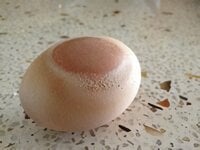
These eggs are the result of two eggs entering and making contact with each other in the shell gland pouch. When this happens, normal calcification (eggshell formation) is interrupted and the first egg that entered the pouch will get an extra layer of calcium, seen as the white band marking. Causes for this are:
- Stress in the flock;
- Changes in lighting, for example adding artificial light in the coop to encourage laying over winter;
- Diseases such as infectious bronchitis.
2. Blood on eggshell
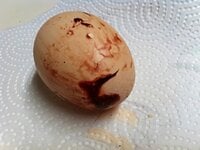
This can be anywhere from a few spots to a smear to an alarming amount of blood. Causes are:
- Small blood vessels ruptured in the hen's vagina from excessive straining. This is more common in young pullets coming into lay and overweight hens;
- Cannibalism, vent pecking;
- Sudden big increase in length of daylight (when supplementing light in winter months);
- A mite/lice infestation around the vent.
3. Body checked egg
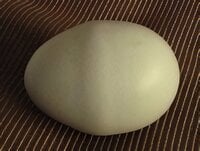
These eggs' shells got cracked during the calcification process and had a layer of calcium deposited over the crack before the egg was laid. Some body checks are covered by a thick layer of calcium, forming a noticeable ridge or band around the egg. Body checks will increase if the hens are exited or get startled late in the afternoon/early evening when the eggshell formation process begins. Causes of body checks are:
- Stress and overcrowding;
- The hen's age. There is a higher incidence of body-checked eggs from older layers.
4. Broken and mended egg
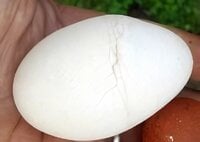
These are similar to body check eggs. The eggshell got cracked during the calcification process and mended just before being laid. Cause:
- Stress, frights, or disturbance during the calcification process.
5. Misshaped or odd-shaped eggs
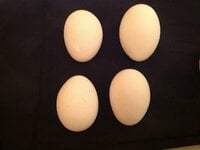
These eggs differ from the normal shape and/or size and can be either too large, too small, round instead of oval or have major changes in shape. Shapes can range from minor, barely noticeable to grossly misshaped. Causes are:
- Immature shell gland (young layers);
- Defective shell glands;
- Disease such as infectious bronchitis;
- Stress, frights, or disturbances;
- Overcrowding in the coop and/or run.
6. Calcium deposits
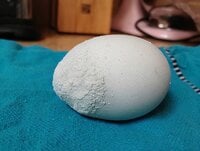
These eggshells have white-colored, irregularly shaped spots deposited onto the external surface of the shell. It can range from a few spots to a severe deposit, as shown in pic #6. Causes are:
- Defective shell glands;
- Disturbances and/or stress during the calcification process;
- Poor nutrition, for example, excess calcium in the hen's diet.
7. Lack of pigment or uneven pigmentation on eggshells
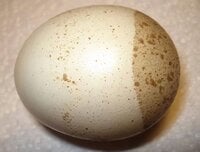
The causes for this can be:
- Poor nutrition. A deficiency in any of the main nutrients, protein, minerals, etc in the hens' diet can influence shell color and formation. Zinc, copper, and manganese are thought to be especially important in transporting pigment onto the shell. It has been suggested that a magnesium supplement can improve shell color:
- Viral infections. Infectious bronchitis and its variants, Newcastle disease, egg drop syndrome, and avian influenza can cause damage to the oviduct, resulting in loss of shell color and other problems:
- Internal and external parasites. A heavy infestation of roundworms and or capillary worms as well as red mites, when present as a heavy infestation, can have an adverse effect on egg quality and may cause pale shells;
- Drugs. The coccidiostat drug, Nicarbazin, if present in the feed, can interfere with eggshell pigmentation;
- The hen's age. And older layer will often produce eggs with paler shells, as well as a hen who had been laying intensively over a long period;
- Stress. Physical stresses, environmental stresses, or nutritional stresses can all interfere with shell pigmentation;
- Exposure to sunlight and high temperatures can produce a fading effect on the shell.
8. Calcium coated egg
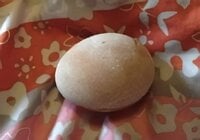
These eggs have an extra, powdery layer of calcium, covering either the entire egg or just one end of the egg. Causes are:
- Defective shell glands;
- Disturbance or stress during calcification process;
- Poor nutrition, for example, excess calcium in the hen's diet.
9. Speckled eggs
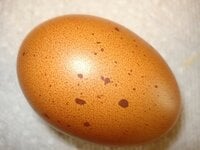
Spots or speckles can be either brown or white. They are similar to calcium deposits, except the speckles are smaller. Speckles may or may not be pigmented. Some of the causes are:
- Stress or disturbance during calcification process;
- Poor nutrition, for example, excess calcium in the hen's diet.
Quoted by member @aart:
'Speckled' eggs can happen for several different reasons...very few, if any, of which are a 'problem'.
Can be caused by:
- Excess or uneven pigment coating.
- Excess or uneven cuticle(bloom).
- Excess calcium deposits.
- Porous eggs can appear speckled.
- Some birds lay them consistently, some only once in a while.
- The pigment or bloom can change appearance when wet, then change back when dry again.
As long as the bird is getting a good diet and is healthy in every other way, it is no cause for concern.
10. Shell-less eggs
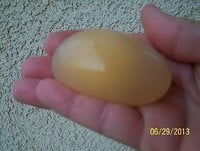
A shell-less egg consists of a yolk, albumen, and membrane, but has no shell at all. The egg contents are protected by the outer membrane only. These are often seen in pullets coming into lay. Causes are:
- Immature shell gland (young layer);
- Nutritional deficiency, usually lack of calcium and vitamins E, B12, and D as well as phosphorous and selenium;
- Certain diseases, such as Newcastle disease, infectious bronchitis, avian influenza, egg drop syndrome;
- Exposure to very high temperatures and extremely high or low humidity levels;
- An infestation of internal or external parasites, such as worms, mites, or lice;
- Stress prompting the hen to lay an egg prematurely, before the shell is formed;
- Egg-laying while molting;
- Exposure to toxins, such as mold, fungi, bacteria.
11. Slab sided or flat-sided egg
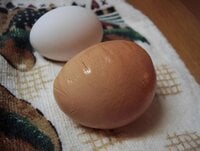
When two eggs enter the shell gland pouch shortly after another, normal calcification is interrupted. The second egg will not be as complete as the first and may be flattened at the side where the eggs made contact, resulting in a flat or slab side. Causes are:
- Disease, such as infectious bronchitis;
- Stress, frights, and disturbances;
- Overcrowding in coop/run;
- Sudden large increase in daily light hours, for example, when supplementing light during winter months.
12. Wrinkled eggs
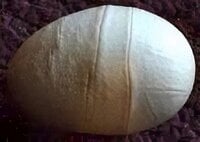
These eggs' shells have thinly creased/wrinkled surfaces. The wrinkles can range in severity from a single small wrinkle to quite a few large wrinkles, as shown in the egg pictured. Causes are:
- Stress and disturbance during calcification process;
- Disease such as infectious bronchitis;
- Defective shell glands.
13. Corrugated shell
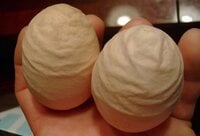
This happens when the egg membrane is thinner than it should be, often as a result of double ovulation (two yolks) and having to stretch thinner to cover the extra egg contents. This results in insufficient plumping of the egg, leaving a corrugated membrane onto which the shell gets deposited, so the shell takes on a corrugated appearance as well. Causes are:
- Extra-large egg size, often double or multi yolk eggs;
- Newcastle disease;
- Excessive use of antibiotics;
- Copper deficiency in the hen's diet;
- Excess calcium consumption;
- A defective shell gland;
- It is often seen with hens recovering from infectious bronchitis;
- It can be hereditary.
14. Yolk-less egg aka fart egg, fairy egg, witch egg, rooster egg, or oops eggs
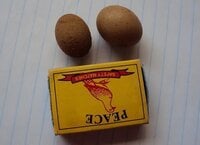
These tiny eggs may or may not have a yolk. Yolk-less fart eggs are often called rooster eggs. These little eggs are often much darker than normal, as they spend more time in the shell gland pouch and get an extra layer or two of pigment. These yolk-less eggs sometimes form when:
- The hen's oviduct releases a small piece of reproductive tissue or another small foreign mass that enters the hen's oviduct, triggering the regular formation of an egg. The foreign object will be treated as a normal yolk and enveloped in albumen, membranes, and a shell;
- Occasionally a hen will also lay a fart egg when something disturbs her reproductive cycle;
- Young pullets may lay a fart egg or two when coming into lay and are still getting their reproductive systems in gear.
15. Soft shell eggs
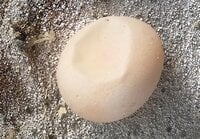
These eggs are laid with an incomplete shell, sometimes just a thin layer of calcium. Causes are similar to shell-less eggs:
- Immature shell gland;
- Nutritional deficiencies, usually lack of calcium, vitamins E, B12, and D as well as phosphorous and selenium;
- Disease such as infectious bronchitis, avian influenza, egg drop syndrome; an internal or external parasite infestation;
- Exposure to very high temperatures and/or very high or low humidity levels;
- Egg laid prematurely due to stress or a disturbance during the calcification process;
- Egg-laying while molting.
16. Mottled eggshells
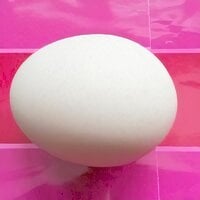
In mottled eggshells, parts of the eggshell are translucent, taking on a mottled or glassy appearance.
These shells can also be thin and fragile. Causes are:
- High humidity in the coop (make sure the coop is well ventilated;
- Certain diseases, (such as infectious bursal disease) and mycotoxins;
- Manganese deficiency in the hen's diet;
- Over-crowding in the coop.
17. Holes in eggshells
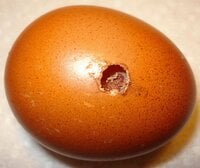
Pinholes, or small holes in the eggshell, may be the result of faulty laying down of the eggshell or from pimples being knocked off the shell. Possible causes are thought to be:
- Advanced layer age
- Poor nutrition
- Damage from toenails, or other sharp objects in the nest box, post laying.
Common Yolk Quality Problems
1. Blood spots
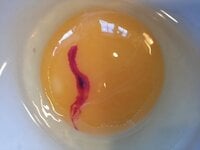
Can range in severity from a small spot of blood on the yolk to about a spoonful of blood mixed with the egg contents. Egg yolks form and mature in the hen's ovary and sometimes when the mature yolk is released it may rupture a small blood vessel, the blood released will end up being encased in the shell, along with the rest of the egg contents. Causes of this can be:
- Incorrect levels of vitamins A and K in the hen's diet;
- Administration of the drug sulphaquinoxaline;
- Large amounts of lucerne meal in the layers' diet;
- Feeding stale, wet, or moldy feed;
- Continuous lighting in the coop;
- Frights, stress, and disturbances.
2. Pale yolks
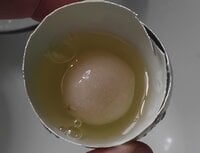
Can be caused by:
- Lack of yellow to red pigments in the hens' diet. Hens who have access to the outdoors, green food such as lucerne and grass, and hens who are fed maize will have deeper colored yolks. Certain feeds contain additives, such as marigold extract to help deepen the yolk color.
3. Mottled yolks
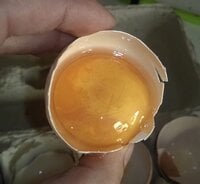
Can be caused by:
- Worming drugs and compounds piperazine, dibutyltin dilaurate, and citrate;
- The anticoccidial drug Nicarbazin;
- Certain antioxidants such as gallic acid and tannic acid;
- Feeding hens raw soybean meal;
- Calcium deficiency in the hens' diet;
- Thin eggshells;
- Can be hereditary.
4. Discoloured (blue-green) yolks
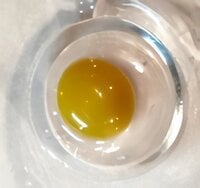
Can be caused by:
- Feed or snacks containing cottonseed oil;
- Ingestion of the weed Shepard's Purse.
5. Double or multiple yolk eggs
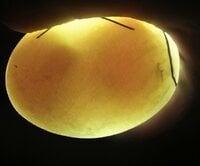
These are more common with your pullets just coming into lay. This happens when more than one yolk matures and gets released at the same time. As many as 9 yolks have been found in a single egg.
6. Rubbery, cheesy or pasty yolks
Are caused by:
- Ingestion of crude cottonseed oil;
- Severe chilling or freezing of intact egg;
- Ingestion of velvet weed and other related species.
7. White or platinum yolks
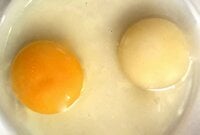
Can be caused by:
- An infestation of cappilaria worms and certain diseases.
Common Albumen Quality problems
1. Meat spots
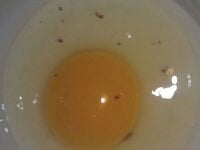
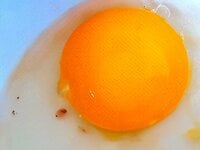
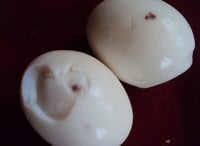
These are usually little bits of the lining of the oviduct which got shed during the egg formation process, but some may be partially broken down blood spots. They often take on the appearance of dirt or soil and vary in color from pale yellow to dark brown or red, as shown in the images. Sizes vary from tiny specks to a few millimeters in diameter. There is a higher incidence of meat spots in eggs from older layers.
2. Thin, watery albumen
This can be caused by:
- Disease such as Newcastle disease, infectious bronchitis, laryngotracheitis, or egg drop syndrome;
- High egg storage temperature;
- High level of ammonia from droppings in the coop (inadequate ventilation/coop hygiene);
- Loss of CO2 from the egg during storage;
- High vanadium levels in feed;
- It can occasionally be a reaction to certain vaccinations.
- There is a higher incidence in eggs from older layers.
3. Off-color albumen
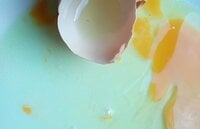
For example pink or green. Cause:
- Spoilage due to Pseudomonas bacteria produces a greenish, fluorescent, water-soluble pigment in the albumen.
- A green tint to albumen can also be caused by the presence of high levels of riboflavin (Vit B2), which has a yellow-green color.
For more information on eggs, egg-laying and egg layers visit the Chicken behaviors and Egg laying forum section.

